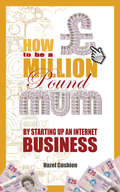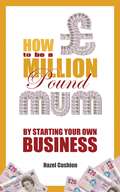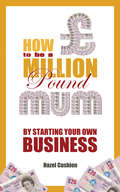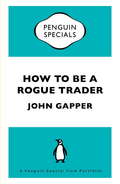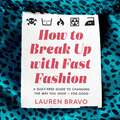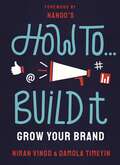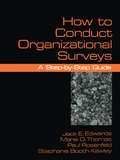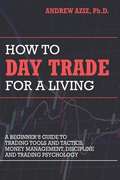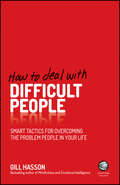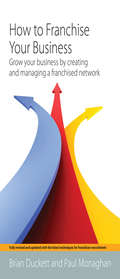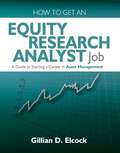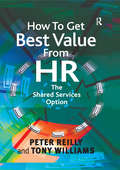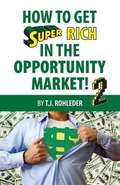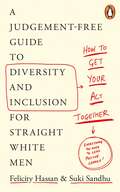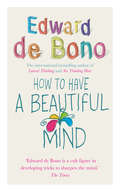- Table View
- List View
How To Be a Million Pound Mum: By Setting Up An Internet Business (How To Be A Million Pound Mum Ser. #2)
by Hazel CushionSo you want to be a great mum and, ideally, a rich one too? Welcome to Million Pound Mum. This range of books offers constructive advice on how to start a business, still be a great mum and have fun while doing it.This book is packed with practical information, top tips and the experiences of mums who have successfully started their own online business. Whether you want to turn your passion into a money-making blog, create your own dream online shop or become a modern day matchmaker with a dating site - this book will offer all the facts and tips you need to get started. Some of have reached the Million Pound Mum goal and others are well on the way.Written in a clear, easy style, this book has all the tools you need to become a Million Pound Mum, online.
How To Be a Million Pound Mum: By Setting Up An Internet Business (How to Be A Million Pound Mum #2)
by Hazel CushionSo you want to be a great mum and, ideally, a rich one too? Welcome to Million Pound Mum. This range of books offers constructive advice on how to start a business, still be a great mum and have fun while doing it.This book is packed with practical information, top tips and the experiences of mums who have successfully started their own online business. Whether you want to turn your passion into a money-making blog, create your own dream online shop or become a modern day matchmaker with a dating site - this book will offer all the facts and tips you need to get started. Some of have reached the Million Pound Mum goal and others are well on the way.Written in a clear, easy style, this book has all the tools you need to become a Million Pound Mum, online.
How To Be a Million Pound Mum: By Starting Your Own Business
by Hazel CushionSo you want to be a great mum and, ideally, a rich one too? Welcome to Million Pound Mum. This range of books offers constructive advice on how to start a business, still be a great mum and have fun while doing it. This book is packed with practical information, top tips and the experiences of mums who have successfully started their own online business. Whether you want to turn your passion into a money-making blog, create your own dream online shop or become a modern day matchmaker with a dating site - this book will offer all the facts and tips you need to get started. Some of have reached the Million Pound Mum goal and others are well on the way. Written in a clear, easy style, this book has all the tools you need to become a Million Pound Mum, online.
How To Be a Million Pound Mum: By Starting Your Own Business (How To Be A Million Pound Mum Ser. #1)
by Hazel CushionSo you want to be a great mum and, ideally, a rich one too? Welcome to Million Pound Mum. This range of books offers constructive advice on how to start a business, still be a great mum and have fun while doing it.Packed with practical information, top tips and the experiences of mums who have successfully started their own companies - some of whom have reached the Million Pound Mum goal and others who are well on the way.Written in a clear, easy style, this book has all the tools you need to become a Million Pound Mum.
How To Be a Million Pound Mum: By Starting Your Own Business (How to Be A Million Pound Mum #1)
by Hazel CushionSo you want to be a great mum and, ideally, a rich one too? Welcome to Million Pound Mum. This range of books offers constructive advice on how to start a business, still be a great mum and have fun while doing it.Packed with practical information, top tips and the experiences of mums who have successfully started their own companies - some of whom have reached the Million Pound Mum goal and others who are well on the way.Written in a clear, easy style, this book has all the tools you need to become a Million Pound Mum.
How To Be a Rogue Trader
by John GapperA compelling, topical e-book on the motives and patterns of rogue traders, and the investment banking system that hosts them, by John Gapper of the Financial Times. Nick Leeson at Barings. Jerome Kerviel at Societe Generale. John Rusnak at Allied Irish Banks. And now the thirty-one-year-old Kweku Adoboli, a director on a derivatives desk who allegedly ran up $2.3 billion in losses at UBS. These are the rogue traders who have bought banks to their knees and global financial systems to a halt. Each time, the banks declare themselves to be innocent victims of a fraud. But why do traders keep on committing apparently senseless crimes, with little benefit apart from higher bonuses and an enormous risk of ending up in prison? And why do banks, which should have learned the tricks of the traders, keep being deceived? In this short e-book, the Financial Times associate editor John Gapper unlocks the mystery by delving into the evolutionary risk-taking instincts of both humans and animals--from yellow-eyed junco sparrows in Arizona to honeybees. He reveals how banks encourage their traders to evade risk limits and shows how the rogue traders merely mimic the strategies used by their firms to seem more profitable than they really are. A rogue trader is often an outsider who starts in a lowly role and secretly gambles with a bank's money in a bid to become a star. Gapper traces patterns of behaviour and personality that could be used to catch them before disaster strikes. But do the banks really want to? And are the rogue traders just the symptoms of a financial system gone rogue?
How To Break Up With Fast Fashion: A guilt-free guide to changing the way you shop – for good
by Lauren Bravo'A funny, achievable guide' Observer'Lauren Bravo is one of my favourite writers' Dolly Alderton'Bravo will inspire you to repair, recycle and give old items a new lease of life' StylistYou probably know the statistics: global clothing production has roughly doubled in just 15 years, and every year an estimated 300,000 tonnes of used clothing ends up in UK landfill.Fast fashion is the ultimate toxic relationship. It's bad news for the planet, our brains and our bank balances. We can't go on like this; our shopping habits need an overhaul.Journalist Lauren Bravo loves clothes more than anything, but she's called time on her affair with fast fashion in search of a slower, saner way of dressing. In this book, she'll help you do the same.How To Break Up With Fast Fashion will help you to change your mindset, fall back in love with your wardrobe and embrace more sustainable ways of shopping - from the clothes swap to the charity shop. Full of refreshing honesty and realistic advice, Lauren will inspire you to repair, recycle and give your unloved items a new lease of life without sacrificing your style.Because fashion belongs to everyone, but no outfit should cost us the earth.
How To Break Up With Fast Fashion: A guilt-free guide to changing the way you shop – for good
by Lauren Bravo'A funny, achievable guide' Observer'Lauren Bravo is one of my favourite writers' Dolly Alderton'Bravo will inspire you to repair, recycle and give old items a new lease of life' StylistYou probably know the statistics: global clothing production has roughly doubled in just 15 years, and every year an estimated 300,000 tonnes of used clothing ends up in UK landfill.Fast fashion is the ultimate toxic relationship. It's bad news for the planet, our brains and our bank balances. We can't go on like this; our shopping habits need an overhaul.Journalist Lauren Bravo loves clothes more than anything, but she's called time on her affair with fast fashion in search of a slower, saner way of dressing. In this book, she'll help you do the same.How To Break Up With Fast Fashion will help you to change your mindset, fall back in love with your wardrobe and embrace more sustainable ways of shopping - from the clothes swap to the charity shop. Full of refreshing honesty and realistic advice, Lauren will inspire you to repair, recycle and give your unloved items a new lease of life without sacrificing your style.Because fashion belongs to everyone, but no outfit should cost us the earth.
How To Break Up With Fast Fashion: A guilt-free guide to changing the way you shop – for good
by Lauren BravoYou probably know the statistics: global clothing production has roughly doubled in just 15 years, and every year an estimated 300,000 tonnes of used clothing ends up in UK landfill. Fast fashion is the ultimate toxic relationship. It's bad news for the planet, our brains and our bank balances. We can't go on like this; our shopping habits need an overhaul.Journalist Lauren Bravo loves clothes more than anything, but she's called time on her affair with fast fashion in search of a slower, saner way of dressing. In this book, she'll help you do the same. How To Break Up With Fast Fashion will help you to change your mindset, fall back in love with your wardrobe and embrace more sustainable ways of shopping - from the clothes swap to the charity shop. Full of refreshing honesty and realistic advice, Lauren will inspire you to repair, recycle and give your unloved items a new lease of life without sacrificing your style. Because fashion belongs to everyone, but no outfit should cost us the earth. (P)2020 Headline Publishing Group Ltd
How To Build It: Grow Your Brand (Merky How To #3)
by Niran Vinod Damola TimeyinIntroducing the new ‘How To…’ series from #Merky Books: unlock your potential with our short, practical pocket-sized guides. _______________________________________________________ How to Build It: Grow Your Brand In a world where everyone is trying to monetise their side hustle and the 5-to-9 is as valuable as the 9-to-5, building your brand is a necessity. But how can you work out what your brand is? How can you make it relevant, and how can you give it real longevity?This indispensable step by step guide will help you understand all the key considerations as you build solid foundations for your brand to thrive and grow. Complete with creative tasks, and shared personal insight from two creative strategists who have worked with some of the world's most renowned brands, How to Build It will set you on the road from nowhere to everywhere. Written by Niran Vinod and Damola Timeyin Foreword by Nando's _______________________________________________________Designed to inspire and encourage readers to unlock their potential and provoke change, the How To series offers a new model in publishing, helping to break down knowledge barriers and uplift the next generation.Creatively presented and packed with clear, step-by-step, practical advice, this series is essential reading for anyone seeking guidance to thrive in the modern world. Curate your bookshelf with these collectible titles.
How To Buy Property at Auction: The Essential Guide To Winning Property And Buy-to-let Bargains
by Samantha CollettBuying property at auction is nerve-wracking, exhilarating and can be hugely profitable - as long as you know the pitfalls to avoid. In this step-by-step guide you will learn why so many successful developers and investors buy at auction - and how you can buy and profit from property auctions.Offering expert tips and guidance you will be walked through the property auction process from start to finish - and be equipped with the knowledge you need to profit from property auctions.Comprehensive and easy to follow, the guide is packed full of case studies, expert tips and watch points for the novice property auction buyer. The guide features: how to find auction property; tips for viewing; preparation checklist; how to calculate your bid price; research the market; raise finance; costs works; check legal paperwork; auction sale day; after the auction; real tales of auction buys; and, a directory of auction houses.
How To Buy Property at Auction: The Essential Guide to Winning Property and Buy-to-Let Bargains
by Samantha CollettBuying property at auction is nerve-wracking, exhilarating and can be hugely profitable - as long as you know the pitfalls to avoid. In this step-by-step guide you will learn why so many successful developers and investors buy at auction - and how you can buy and profit from property auctions.Offering expert tips and guidance you will be walked through the property auction process from start to finish - and be equipped with the knowledge you need to profit from property auctions.Comprehensive and easy to follow, the guide is packed full of case studies, expert tips and watch points for the novice property auction buyer. The guide features: how to find auction property; tips for viewing; preparation checklist; how to calculate your bid price; research the market; raise finance; costs works; check legal paperwork; auction sale day; after the auction; real tales of auction buys; and, a directory of auction houses.
How To Buy Your Home and Save Money: Use insider knowledge to cut costs and avoid expensive mistakes
by Susie HealThis book gives home buyers the knowledge they need to buy a home, and do it right. It covers all areas of the purchase process, whether you are buying for the first time or want to improve on your last experience. Buying property is an expensive business. Apart from the price of the property itself, there are costs and fees every step of the way. But some of these can be avoided or significantly reduced - if you know how. Ø How to negotiate the offerØ Finding a value mortgageØ Using the survey resultsØ Includes leasehold, new build, auctions and joint purchaseØ Explains the costs and fees, and how to reduce them;Ø Advice on handling the paperworkØ Includes really useful Money Saving TipsFrom finding the right property to arranging the funding and completing your purchase, this book will guide you along the way and save you money.
How To Buy Your Home and Save Money: Use insider knowledge to cut costs and avoid expensive mistakes
by Susie HealThis book gives home buyers the knowledge they need to buy a home, and do it right. It covers all areas of the purchase process, whether you are buying for the first time or want to improve on your last experience. Buying property is an expensive business. Apart from the price of the property itself, there are costs and fees every step of the way. But some of these can be avoided or significantly reduced - if you know how. Ø How to negotiate the offerØ Finding a value mortgageØ Using the survey resultsØ Includes leasehold, new build, auctions and joint purchaseØ Explains the costs and fees, and how to reduce them;Ø Advice on handling the paperworkØ Includes really useful Money Saving TipsFrom finding the right property to arranging the funding and completing your purchase, this book will guide you along the way and save you money.
How To Conduct Organizational Surveys: A Step-by-Step Guide
by Marie D. Thomas Paul Rosenfeld Stephanie Booth-Kewley Jack EdwardsOrganizations are increasingly turning to surveys to solve many business-related problems. This book provides those who want to plan organizational surveys with a step-by-step, `how-to' guide. The authors describe the issues that must be addressed at each step in the process, the advantages and disadvantages that result from many of the choices that must be made, and practical lessons learned from their years of experience in designing and conducting surveys.
How To Day Trade For A Living: A Beginner Guide On Important Day Trading Strateg
by Andrew AzizIn How to Day Trade for a Living, I will show you how you too can take control over your life and have success in day trading on the stock market. I love teaching. It's my passion. In this book, I use simple and easy to understand words to explain the strategies and concepts you need to know to launch yourself into day trading on the stock market. This book is definitely NOT a difficult, technical, hard to understand, complicated and complex guide to the stock market. It's concise. It's practical. It's written for everyone. You can learn how to beat Wall Street at its own game.
How To Deal With Difficult People
by Gill HassonDON'T LET PROBLEM PEOPLE GET TO YOU!Whether it's a manager who keeps moving the goal posts, an uncooperative colleague, negative friend, or critical family member, some people are just plain hard to get along with.Often, your immediate response is to shrink or sulk, become defensive or attack. But there are smarter moves to make when dealing with difficult people. This book explains how to cope with a range of situations with difficult people and to focus on what you can change.This book will help you to:Understand what makes difficult people tick and how best to handle themLearn ways to confidently stand up to others and resist the urge to attack backDevelop strategies to calmly navigate emotionally-charged situationsDeal with all kinds of difficult people - hostile, manipulative and the impossibleKnow when to choose your battles, and when to walk awayWhy let someone else's bad attitude ruin your day? How to Deal With Difficult People arms you with all the tools and tactics you need to handle all kinds of people - to make your life less stressful and a great deal easier.
How To Franchise Your Business 2nd Edition: Grow your business by creating and managing a franchised network
by Brian Duckett Paul MonaghanLearn how to effectively expand your business system and reap the benefits of growthIf you have a proven business system and are wishing to expand, franchising is a strong option. It provides a quick route to growth and uses other people's money and enthusiasm to open individual offices, shops, restaurants, salons, surgeries, units, van rounds, or service centres. This book provides practical advice on how franchising works from two authors with years of experience. As well as being for potential franchisors, this book is also invaluable to owners of existing branch networks, practising franchisors and their management teams, and candidates for the Diploma in Franchise Management. It will show you how to: - Decide whether your business should and could be franchised - Understand the franchisor/franchisee relationship - Structure the business so it works for both franchisor and franchisee - Prove the concept with pilot operations - Market your franchise and recruit franchisees - Motivate franchisees and monitor their performance - Franchise your business internationally - Prepare your network for sale - or buy an existing franchised networkContents: Acknowledgements; Preface; SECTION I - THE BASICS; 1. Introduction; 2. Business format franchising - a growth option for your business?; 3. The franchised network development plan; 4. The franchisor/franchisee relationship; 5. Pilot operations; 6. Building the franchisor management team; 7. The franchise operations manual; 8. The franchise agreement; 9. International franchising; SECTION 2 - PRACTICAL FRANCHISE; MANAGEMENT; 10. How to market a franchise; 11. How to recruit franchisees; 12. How to get the best results from franchise exhibitions; 13. How to help franchisees prepare and review their business plans; 14. How to write the franchise operations manual; 15. How to develop and deliver a franchise training programme; 16. How to monitor franchisees' performance; 17. How to motivate franchisees; 18. How to get the best from field visits; 19. How to manage franchise unit resales; 20. How to monitor your performance as a franchisor; 21. How to avoid legal problems for you and your franchisees; SECTION 3 - ADVANCED FRANCHISING; 22. Becoming an international franchisor; 23. Becoming a master franchisee; 24. Meeting your international match; 25. Negotiating the international arrangements; 26. Buying or selling an existing franchised network; Appendices; Index
How To Franchise Your Business: Grow Your Business By Creating And Managing A Franchised Network
by Brian Duckett Paul MonaghanIf you have a proven business system and are wishing to expand, franchising is a strong option. It provides a quick route to growth and uses other people's money and enthusiasm to open individual offices, shops, restaurants, salons, surgeries, units, van rounds, or service centres. / This book provides practical advice on how franchising works from two authors with years of experience. As well as being for potential franchisors, this book is also invaluable to owners of existing branch networks, practising franchisors and their management teams, and candidates for the Diploma in Franchise Management. It will show you how to: * Decide whether your business should and could be franchised. * Understand the franchisor/franchisee relationship. * Structure the business so it works for both franchisor and franchisee. * Prove the concept with pilot operations. * Market your franchise and recruit franchisees. * Motivate franchisees and monitor their performance. * Franchise your business internationally. * Prepare your network for sale - or buy an existing franchised network.
How To Get An Equity Research Analyst Job: A Guide to Starting a Career in Asset Management
by Gillian D. ElcockDo you want to get a job in the asset management industry, analyzing stocks or managing portfolios? How do you go about convincing a company to give you a job? What will the interviews by like and how should you prepare? This title guides you from choosing which companies to target, to mastering the specialized interview process.
How To Get Best Value From HR: The Shared Services Option
by Tony Williams Peter ReillyAn efficient and cost-effective HR function is essential to the successful running of any organization. And yet for many businesses it is impossible or costly to have HR staff in every office. This is particularly true for companies who have many branches, such as banks and building societies. So what are they to do? Increasingly they are turning to shared services by creating a unit within the organization that typically undertakes personnel administration and basic operational support. This may be delivered to managers and employees through some combination of call centre, personal contact or intranet. Creating a shared services centre enables the HR function to redefine its relationship with its stakeholders. It can become more of a strategic player and make a more business-focused contribution. This book explains what shared services are and what they look like for the HR function. It describes why organizations opt for shared services and what activities are included. It sets out the relationship between shared services and the other HR activities, and between HR and line management. How To Get Best Value From HR outlines the process of introducing shared services, from identifying customer needs through designing the structure to implementation and monitoring. It also outlines the likely pitfalls and, importantly, offers possible solutions. In particular the book highlights the big design issues, including whether to outsource services, where a shared services centre should be located, how services should be delivered and organized, including through the option of e-HR. Crucially it features an extended case study of the Royal Bank of Scotland's experience of introducing HR shared services, providing a unique insight into the reality of this new way of working.
How To Get Super Rich In The Opportunity Market! 2
by T. J. RohlederT.J. Rohleder and his wife Eileen got started in the opportunity market back in September of 1988 with only a few hundred dollars and a really great idea for a red-hot money-making plan. They wrote a simple booklet about our plan and ran a tiny ad in a national magazine to sell it... and became millionaires in less than 5 years! The rest, shall we say, is history. T.J. has been in the opportunity market ever since. That was many years ago and many days he's still like a kid in a candy store. Huge stacks of orders come pouring into his office in little Goessel, Kansas. He gets orders online, by phone, and fax 24 hours a day, 7 days a week - even when no one is in the office. Now you can use his same methods and strategies and potentially have a business that brings you millions of dollars too! Read and study this rare and unusual book to discover how!
How To Get Your Act Together: A Judgement-Free Guide to Diversity and Inclusion for Straight White Men
by Suki Sandhu Felicity Hassan'Obligatory reading for anyone - straight, white and male or otherwise - who wants to do better but doesn't know where to start.' - People Management'A pivotal guide for going from awareness to action in creating a more diverse and inclusive workplace and society.' - Marc Benioff, CEO of Salesforce--------EVERYTHING YOU NEED TO CREATE AND LEAD AN INCLUSIVE, DIVERSE TEAMThe business case for diversity and inclusion is clear - it drives innovation, profit and employer brand. But how can male white leaders help implement this change? There's no denying it's difficult - perhaps you feel left out of the conversation, afraid to make mistakes, and confused about the evolving language of diversity and inclusion.In this practical guide, leading diversity specialists Felicity Hassan and Suki Sandhu OBE teach you how to create an inclusive environment for your employees and have educated conversations about diversity, navigating what can sometimes be tricky territory with humour and heart.--------'A must-read and a powerful call to seize the opportunity that lies in embracing and celebrating people for who they are.' - Richard Branson, CEO & Founder of The Virgin Group'It takes a good deal of self-awareness and continuous learning to really ingrain the behavioural changes that are needed. This book holds up a mirror and then guides us - skilfully and persuasively - to the actions we all need to be taking.' - Alan Jope, CEO of Unilever
How To Grow Your Business On The Internet
by Vincent EmeryFor the computer challenged potential entrepreneur, extols the benefits of opening shop on Cyberstreet, explains the requirements and protocols, outlines business strategies, warns against accidents and attacks, and suggests 11 businesses that might work. Further information is available free on the World Wide Web. A list of free business resources on the Internet stands in for a bibliography. Annotation c. by Book News, Inc. , Portland, Or.
How To Have A Beautiful Mind
by Edward de BonoPeople spend a fortune on their bodies, their faces, their hair, their clothes. Cosmetics, plastic surgery, diets, gym membership - everyone's trying to be more attractive. But there's an easier way to become a beautiful person. It doesn't have to be physical. No matter how you look, if you have a mind that's fascinating, creative, exciting - if you're a good thinker - you can be beautiful.And being attractive doesn't necessarily come from being intelligent or highly-educated. It isn't about having a great personality. It's about using your imagination and expanding your creativity. And it's when talking with people that we make the greatest impact. A person may be physically beautiful, but when speaking to others a dull or ugly or uncreative mind will definitely turn them off.In clear, practical language, de Bono shows how by applying lateral and parallel thinking skills to your conversation you can improve your mind. By learning how to listen, make a point, and manoeuvre a discussion, you can become creative and more appealing - more beautiful.
